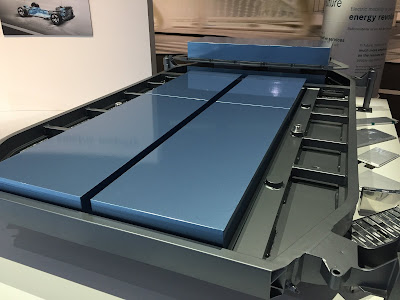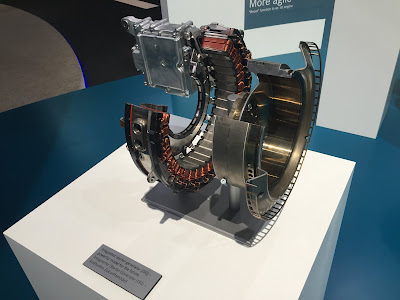Audi reveal eROT energy harvesting ‘regen’ shock absorders
We have reported on a wide range of energy regenerative shock absorbers over the years that most often convert linear motion into electricity. Audi is working on a prototype called “eROT,” in which electric motors replace telescopic shock absorbers in the form of electromechanical rotary dampers.
The principle behind eROT is easily explained: “Every pothole, every bump, every curve induces kinetic energy in the car. Today’s dampers absorb this energy, which is lost in the form of heat,” said Dr.-Ing. Stefan Knirsch, Board Member for Technical Development at AUDI AG. “With the new electromechanical damper system in the 48-volt electrical system, we put this energy to use. It also presents us and our customers with entirely new possibilities for adjusting the suspension.”
The eROT system responds quickly and with minimal inertia. As an actively controlled suspension, it adapts ideally to irregularities in the road surface and the driver’s driving style. A damper characteristic that is virtually freely definable via software increases the functional scope. It eliminates the mutual dependence of the rebound and compression strokes that limits conventional hydraulic dampers. With eROT, Audi configures the compression stroke to be comfortably soft without compromising the taut damping of the rebound stroke. Another advantage of the new damper system is its geometry. The horizontally arranged electric motors in the rear axle area replace the upright telescopic shock absorbers, which allows for additional space in the luggage compartment.
The eROT system enables a second function besides the freely programmable damper characteristic: It can convert the kinetic energy during compression and rebound into electricity. To do this, a lever arm absorbs the motion of the wheel carrier. The lever arm transmits this force via a series of gears to an electric motor, which converts it into electricity. The recuperation output is 100 to 150 watts on average during testing on German roads – from 3 watts on a freshly paved freeway to 613 watts on a rough secondary road. Under customer driving conditions, this corresponds to a CO2 savings of up to three grams per kilometer (4.8 g/mi).
The new eROT technology is based on a high-output 48-volt electrical system. As currently configured, its lithium-ion battery offers an energy capacity of 0.5 kilowatt hours and peak output of 13 kilowatts. A DC converter connects the 48-volt electrical subsystem to the 12-volt primary electrical system, which includes a high-efficiency, enhanced output generator.
Initial test results for the eROT technology are promising, thus its use in future Audi production models is certainly plausible. A prerequisite for this is the 48-volt electrical system, which is a central component of Audi’s electrification strategy. In the next version planned for 2017, the 48-volt system will serve as the primary electrical system in a new Audi model and feed a high-performance mild hybrid drive. It will offer potential fuel savings of up to 0.7 liters per 100 kilometers.
Driven | 2016 Toyota Prius
Video Review: Decent Handling in a Toyota Prius? Yes, the New One
Elon Musk of Tesla Sticks to Mission Despite Setbacks
Samsung buys $450 million stake in Chinese electric car firm BYD
Samsung Electronics will pay $450 million for a stake in Chinese automaker and rechargeable batteries firm BYD Co Ltd, the Chinese company said in a stock exchange filing on Thursday.
Automakers and technology companies have formed a series of partnerships in recent years as the race to develop electric, self-driving, internet-connected vehicles has created demand for more electronics components and software.
The Samsung investment has been made through Chinese subsidiary Shanghai Samsung Semiconductor and gives the Korean firm a 1.92 percent stake in BYD, making it the ninth largest investor in the company.
Samsung Electronics said last week it was in talks to acquire a stake in BYD to boost its automotive chip business, after the Korea Economic Daily first reported that Samsung had agreed to buy a stake.
BYD, which also counts Warren Buffet's Berkshire Hathaway as a backer, began as a battery maker for personal electronics before launching its automotive business that focuses on electric and hybrid vehicles.
Rimac Concept_One 0-100 km/h acceleration [VIDEO]
This is what 0-100 km/h in 2.6 seconds looks like.
The Concept One’s powertrain consists of four electric motors and four gearboxes with a total of 800 kW (1088 hp) and 1,600 Nm (1,180 ft-lb) distributed via torque vectoring.
The 620 volt, 82 kWh, LiNiMnCoO2 battery’s 1 MegaWatt of discharge capability linked to those four wheels moves the two-ton hypercar to 62.5 mph in just 2.6 seconds, to 124 mph in 6.2 seconds and to 186 mph in 14.2 seconds.
Top speed is rated at 221 mph.
Atieva testing AWD powertrain in 900-hp Electric Van [VIDEO]
One of the four Chinese backed EV start-ups in Silicon Valley, Atieva was started by former executives from Tesla and Oracle in late 2007.
As Reuters reports, Atieva is headed by Bernard Tse, an ex-Tesla Vice President and board member, as well as Peter Rawlinson, the former chief engineer of the Tesla Model S. They don't have a factory yet, but they do have a van nicknamed Edna.
With its first car still at least two years away from production, Atieva is using a Mercedes-Benz Vito commercial van to test the drivetrain: a pair of high-output electric motors, a 87 kWh lithium-ion battery pack, inverters, gearboxes and dual motor controller.
Rawlinson, who while at Tesla led engineering of the Model S sedan, said Atieva's "secret sauce" is the software tying all that hardware together to deliver a combined 900 horsepower to the 2,200 kg all-wheel-drive van. With a dual motor powertrain the company is clearly not testing full-spec torque vectoring (which requires 4x motors).
The drivetrain propels the van from zero to 60 mph in just 3.1 seconds, a fraction slower than the fastest Tesla Model S. Atieva’s 0-60 acceleration target for its 2018 sedan is 2.7 seconds.
The Atieva sedan, being developed under the code name Project Cosmos, looks like a futuristic descendent of the Audi A7. Its headlamps are ultra-thin, with thousands of insect-inspired micro lenses. Its dashboard has a three-piece reconfigurable digital display that can be controlled by voice or touch.
Atieva has raised several hundred million dollars from investors including Mitsui & Co Ltd, the Japanese trading giant, and Venrock, a Silicon Valley venture capital firm connected with the Rockefeller family that once funded Intel and Apple. Two of Atieva’s biggest shareholders are Chinese: State-owned Beijing Auto and a subsidiary of publicly traded LeEco, an internet company that has also declared it intends to offer an electric car. LeEco is controlled by Chinese tech entrepreneur Jia Yueting.
Mercedes-Benz to electrify all model series in €7B R&D investment
Over the next two years, Daimler is slated to invest an unprecedented seven billion euro (approximately $7.8 billion in US) into what they are referring to as green technologies. Usually, such a large sum of money would be invested over a long period of time, but Daimler is leading the industry in doing so over a mere two years. By 2017, the car maker will offer all models with electrified powertrains.
According to Professor Dr. Thomas Weber, a member of the Board of management of Dimler AG, stated, “…no other manufacturer offers a comparable range of electrified vehicles and solutions in the field of electric mobility. The spectrum ranges from the smart city runabout and attractive Mercedes-Benz passenger cars to buses, coaches, and trucks of the Fuso brand. We will electrify all Mercedes-Benz passenger car model series step by step.“
The Mercedes-Benz name will not be compromised by lack of power, as stated in a press release, but will instead offer customers a broader range of engine options, keeping in mind the specific needs of each model and the desires of the purchaser. Mercedes-Benz will offer a multitude of plug-in hybrids and expand carbon-free options by implementing emission-free vehicles into every realm of their model options including buses and commercial vehicles. The car maker recognizes a need for more innovative technology within the automotive industry though, and is making great strides toward the future.
Mercedes-Benz will unveil a high-performance four-door, four-seat, all-wheel drive GT electric only saloon with 500 km range at the Paris motor show in October.
Source: Daimler
All-electric 4-motor SH-AWD NSX EV Concept to race @ Pikes Peak
Acura will field a pair of 2017 Acura NSX supercars in the 100th Anniversary of the running of the Broadmoor Pikes Peak International Hill Climb on June 26, marking the North American racing debut of Acura's next-generation NSX: the pinnacle expression of Acura Precision Crafted Performance and the only supercar made in America.
The two Acura NSX supercars will compete in the Time Attack 1 and 2 classes and will be piloted by brothers James and Nick Robinson, respectively, both from the company's North American engineering team. In addition, Acura will campaign an NSX-inspired prototype vehicle in the Electric Modified Class, featuring a further evolution of the experimental all-electric, 4-motor Super Handling All-Wheel Drive (SH-AWD) powertrain that won last year's Pikes Peak Challenge Exhibition class.
"Pikes Peak is like no other race in the world and offers a unique opportunity to showcase the power and performance of our products," said Jon Ikeda, vice president and general manager of the Acura Division. "We are excited for this year's 'Race to the Clouds' to test the endurance and engineering of the Acura NSX and our advanced powertrain technologies – as well as an expression of our racing spirit."
A team of North American R&D engineers has been working on both NSX entries, which feature the same three-motor Sport Hybrid Super-Handling All-Wheel Drive powertrain (Sport Hybrid SH-AWD) as the production NSX. This powertrain features a twin-turbo V6 engine mated to a 9-speed dual clutch transmission and Rear Direct Drive Motor, and a front Twin Motor Unit with a world's first electrically powered torque vectoring capability in the supercar realm. Modifications to the NSX competing in the Time Attack 1 class included chassis lightening and a custom high-flow racing exhaust.
The NSX competing in the Time Attack 2 class is a production car with the required safety equipment for competition. The Time Attack 1 NSX will be driven by James Robinson of the company's North American powertrain development group, who drove a first-generation NSX in the Pikes Peak Hill Climb from 2012 to 2015. His brother Nick Robinson, an engineer in charge of the new NSX's dynamic performance during its development, will drive the Time Attack 2 NSX. Nick is also the reigning PP250 winner from the 2015 Pikes Peak Hill Climb.
The supercar-inspired 4-Motor EV Concept will be driven by Tetsuya Yamano, who campaigned last year's CR-Z-based electric prototype. The EV Concept is the ultimate embodiment of the all-wheel-drive Electric SH-AWD powertrain featuring a world's first technology that enables four-wheel independent torque allocation. The Electric SH-AWD powertrain, an evolution of the CR-Z prototype powertrain, produces three times the total system output of last year's electric prototype and is mated to the NSX body.
As Official Pace Car sponsor, Acura will feature three pace cars – the NSX, the seven-passenger MDX performance-luxury SUV and the TLX sports sedan. President of Polyphony Digital and Producer of the Gran Turismo series Kazunori Yamauchi and Pikes Peak legends Randy Schranz and Leonard Vahsholtz will lead the field of 100 entrants to the top of the 14,115-foot Colorado peak.
For Pikes Peak race attendees, the NSX and other pace cars will appear at a number of pre-race activities, including the popular Fan Fest in downtown Colorado Springs, 5 to 10 p.m. MDT Friday, June 24.











